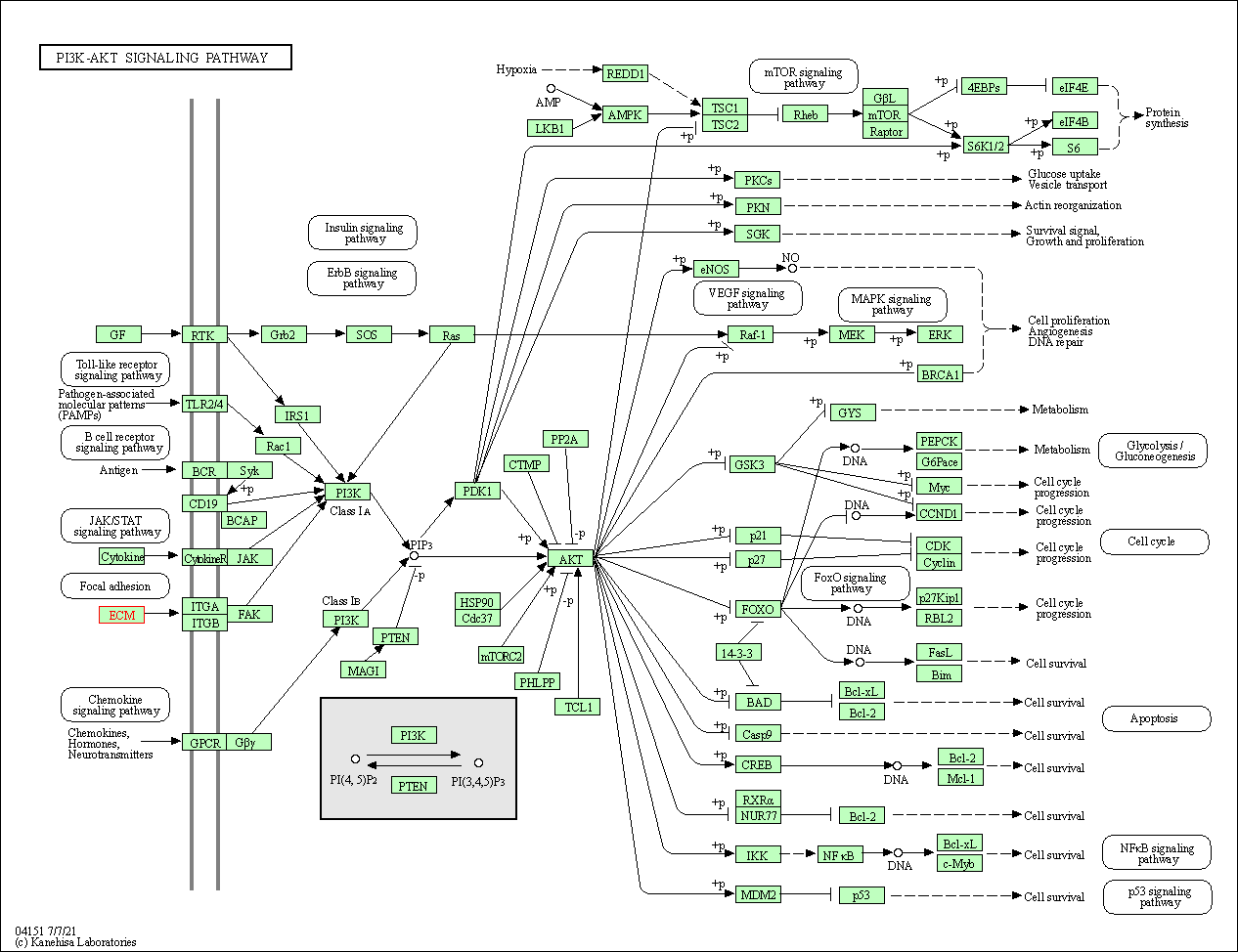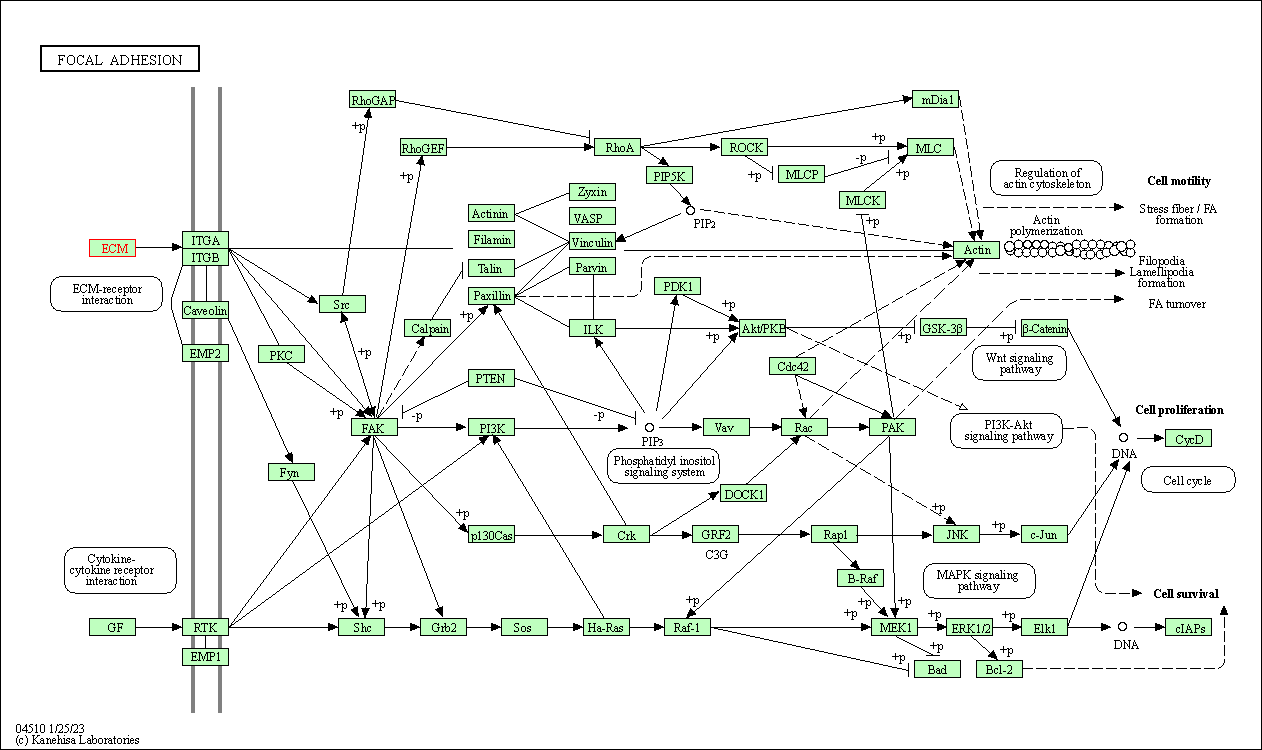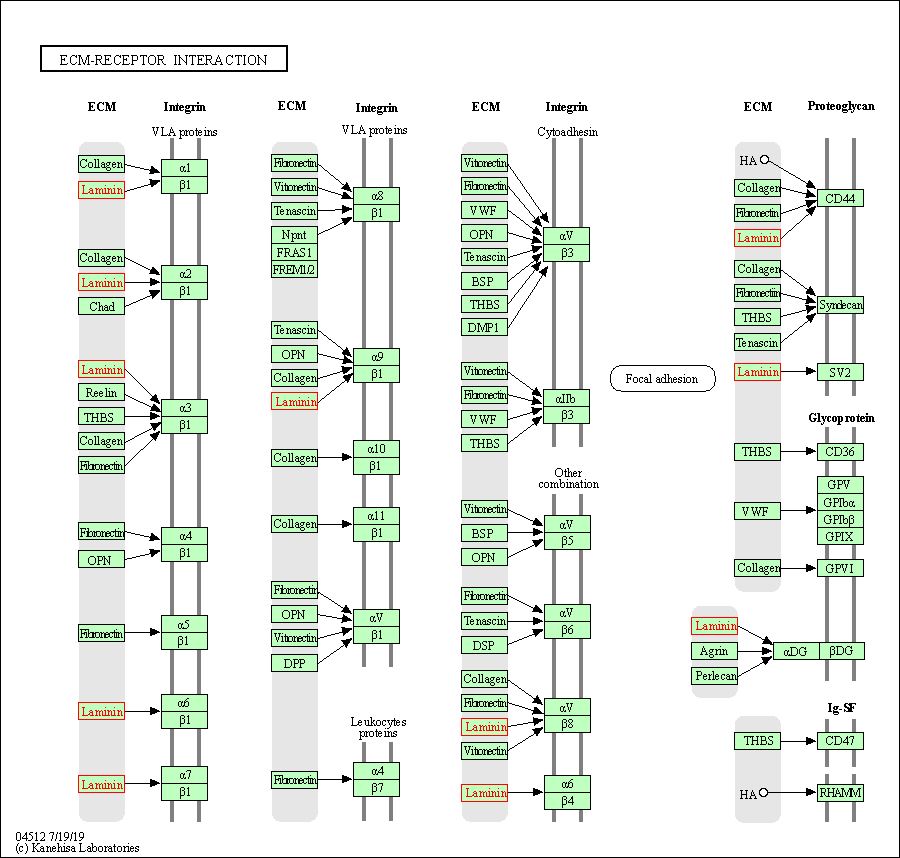Target Information
| Target General Information | Top | |||||
|---|---|---|---|---|---|---|
| Target ID |
T75613
(Former ID: TTDI02360)
|
|||||
| Target Name |
Laminin gamma-2 subunit (LAMC2)
|
|||||
| Synonyms |
Nicein subunit gamma; Large adhesive scatter factor 140 kDa subunit; Laminin5 subunit gamma; Laminin-5 subunit gamma; Laminin subunit gamma2; Laminin subunit gamma-2; Laminin B2t chain; Ladsin 140 kDa subunit; LAMNB2; LAMB2T; Kalinin/nicein/epiligrin 100 kDa subunit; Kalinin subunit gamma; Epiligrin subunit gamma; Cellscattering factor 140 kDa subunit; Cell-scattering factor 140 kDa subunit; CSF 140 kDa subunit
Click to Show/Hide
|
|||||
| Gene Name |
LAMC2
|
|||||
| Target Type |
Literature-reported target
|
[1] | ||||
| Disease | [+] 1 Target-related Diseases | + | ||||
| 1 | Solid tumour/cancer [ICD-11: 2A00-2F9Z] | |||||
| Function |
Ladsin exerts cell-scattering activity toward a wide variety of cells, including epithelial, endothelial, and fibroblastic cells. Binding to cells via a high affinity receptor, laminin is thought to mediate the attachment, migration and organization of cells into tissues during embryonic development by interacting with other extracellular matrix components.
Click to Show/Hide
|
|||||
| UniProt ID | ||||||
| Sequence |
MPALWLGCCLCFSLLLPAARATSRREVCDCNGKSRQCIFDRELHRQTGNGFRCLNCNDNT
DGIHCEKCKNGFYRHRERDRCLPCNCNSKGSLSARCDNSGRCSCKPGVTGARCDRCLPGF HMLTDAGCTQDQRLLDSKCDCDPAGIAGPCDAGRCVCKPAVTGERCDRCRSGYYNLDGGN PEGCTQCFCYGHSASCRSSAEYSVHKITSTFHQDVDGWKAVQRNGSPAKLQWSQRHQDVF SSAQRLDPVYFVAPAKFLGNQQVSYGQSLSFDYRVDRGGRHPSAHDVILEGAGLRITAPL MPLGKTLPCGLTKTYTFRLNEHPSNNWSPQLSYFEYRRLLRNLTALRIRATYGEYSTGYI DNVTLISARPVSGAPAPWVEQCICPVGYKGQFCQDCASGYKRDSARLGPFGTCIPCNCQG GGACDPDTGDCYSGDENPDIECADCPIGFYNDPHDPRSCKPCPCHNGFSCSVMPETEEVV CNNCPPGVTGARCELCADGYFGDPFGEHGPVRPCQPCQCNNNVDPSASGNCDRLTGRCLK CIHNTAGIYCDQCKAGYFGDPLAPNPADKCRACNCNPMGSEPVGCRSDGTCVCKPGFGGP NCEHGAFSCPACYNQVKIQMDQFMQQLQRMEALISKAQGGDGVVPDTELEGRMQQAEQAL QDILRDAQISEGASRSLGLQLAKVRSQENSYQSRLDDLKMTVERVRALGSQYQNRVRDTH RLITQMQLSLAESEASLGNTNIPASDHYVGPNGFKSLAQEATRLAESHVESASNMEQLTR ETEDYSKQALSLVRKALHEGVGSGSGSPDGAVVQGLVEKLEKTKSLAQQLTREATQAEIE ADRSYQHSLRLLDSVSRLQGVSDQSFQVEEAKRIKQKADSLSSLVTRHMDEFKRTQKNLG NWKEEAQQLLQNGKSGREKSDQLLSRANLAKSRAQEALSMGNATFYEVESILKNLREFDL QVDNRKAEAEEAMKRLSYISQKVSDASDKTQQAERALGSAAADAQRAKNGAGEALEISSE IEQEIGSLNLEANVTADGALAMEKGLASLKSEMREVEGELERKELEFDTNMDAVQMVITE AQKVDTRAKNAGVTIQDTLNTLDGLLHLMDQPLSVDEEGLVLLEQKLSRAKTQINSQLRP MMSELEERARQQRGHLHLLETSIDGILADVKNLENIRDNLPPGCYNTQALEQQ Click to Show/Hide
|
|||||
| 3D Structure | Click to Show 3D Structure of This Target | AlphaFold | ||||
| Drugs and Modes of Action | Top | |||||
|---|---|---|---|---|---|---|
| Preclinical Drug(s) | [+] 1 Preclinical Drugs | + | ||||
| 1 | BST-1005 | Drug Info | Preclinical | Solid tumour/cancer | [2] | |
| Cell-based Target Expression Variations | Top | |||||
|---|---|---|---|---|---|---|
| Cell-based Target Expression Variations | ||||||
| Different Human System Profiles of Target | Top |
|---|---|
|
Human Similarity Proteins
of target is determined by comparing the sequence similarity of all human proteins with the target based on BLAST. The similarity proteins for a target are defined as the proteins with E-value < 0.005 and outside the protein families of the target.
A target that has fewer human similarity proteins outside its family is commonly regarded to possess a greater capacity to avoid undesired interactions and thus increase the possibility of finding successful drugs
(Brief Bioinform, 21: 649-662, 2020).
Human Tissue Distribution
of target is determined from a proteomics study that quantified more than 12,000 genes across 32 normal human tissues. Tissue Specificity (TS) score was used to define the enrichment of target across tissues.
The distribution of targets among different tissues or organs need to be taken into consideration when assessing the target druggability, as it is generally accepted that the wider the target distribution, the greater the concern over potential adverse effects
(Nat Rev Drug Discov, 20: 64-81, 2021).
Human Pathway Affiliation
of target is determined by the life-essential pathways provided on KEGG database. The target-affiliated pathways were defined based on the following two criteria (a) the pathways of the studied target should be life-essential for both healthy individuals and patients, and (b) the studied target should occupy an upstream position in the pathways and therefore had the ability to regulate biological function.
Targets involved in a fewer pathways have greater likelihood to be successfully developed, while those associated with more human pathways increase the chance of undesirable interferences with other human processes
(Pharmacol Rev, 58: 259-279, 2006).
Biological Network Descriptors
of target is determined based on a human protein-protein interactions (PPI) network consisting of 9,309 proteins and 52,713 PPIs, which were with a high confidence score of ≥ 0.95 collected from STRING database.
The network properties of targets based on protein-protein interactions (PPIs) have been widely adopted for the assessment of target’s druggability. Proteins with high node degree tend to have a high impact on network function through multiple interactions, while proteins with high betweenness centrality are regarded to be central for communication in interaction networks and regulate the flow of signaling information
(Front Pharmacol, 9, 1245, 2018;
Curr Opin Struct Biol. 44:134-142, 2017).
Human Similarity Proteins
Human Tissue Distribution
Human Pathway Affiliation
Biological Network Descriptors
|
|
|
Note:
If a protein has TS (tissue specficity) scores at least in one tissue >= 2.5, this protein is called tissue-enriched (including tissue-enriched-but-not-specific and tissue-specific). In the plots, the vertical lines are at thresholds 2.5 and 4.
|
| KEGG Pathway | Pathway ID | Affiliated Target | Pathway Map |
|---|---|---|---|
| PI3K-Akt signaling pathway | hsa04151 | Affiliated Target |

|
| Class: Environmental Information Processing => Signal transduction | Pathway Hierarchy | ||
| Focal adhesion | hsa04510 | Affiliated Target |

|
| Class: Cellular Processes => Cellular community - eukaryotes | Pathway Hierarchy | ||
| ECM-receptor interaction | hsa04512 | Affiliated Target |

|
| Class: Environmental Information Processing => Signaling molecules and interaction | Pathway Hierarchy | ||
| Degree | 8 | Degree centrality | 8.59E-04 | Betweenness centrality | 2.86E-05 |
|---|---|---|---|---|---|
| Closeness centrality | 1.93E-01 | Radiality | 1.33E+01 | Clustering coefficient | 5.00E-01 |
| Neighborhood connectivity | 1.61E+01 | Topological coefficient | 2.44E-01 | Eccentricity | 13 |
| Download | Click to Download the Full PPI Network of This Target | ||||
| Target Regulators | Top | |||||
|---|---|---|---|---|---|---|
| Target-regulating microRNAs | ||||||
| Target Affiliated Biological Pathways | Top | |||||
|---|---|---|---|---|---|---|
| KEGG Pathway | [+] 7 KEGG Pathways | + | ||||
| 1 | PI3K-Akt signaling pathway | |||||
| 2 | Focal adhesion | |||||
| 3 | ECM-receptor interaction | |||||
| 4 | Toxoplasmosis | |||||
| 5 | Amoebiasis | |||||
| 6 | Pathways in cancer | |||||
| 7 | Small cell lung cancer | |||||
| PID Pathway | [+] 3 PID Pathways | + | ||||
| 1 | Beta1 integrin cell surface interactions | |||||
| 2 | Alpha6 beta4 integrin-ligand interactions | |||||
| 3 | a6b1 and a6b4 Integrin signaling | |||||
| Reactome | [+] 5 Reactome Pathways | + | ||||
| 1 | Degradation of the extracellular matrix | |||||
| 2 | Assembly of collagen fibrils and other multimeric structures | |||||
| 3 | Anchoring fibril formation | |||||
| 4 | Laminin interactions | |||||
| 5 | Non-integrin membrane-ECM interactions | |||||
| WikiPathways | [+] 8 WikiPathways | + | ||||
| 1 | Inflammatory Response Pathway | |||||
| 2 | Focal Adhesion | |||||
| 3 | Assembly of collagen fibrils and other multimeric structures | |||||
| 4 | Alpha 6 Beta 4 signaling pathway | |||||
| 5 | miR-targeted genes in muscle cell - TarBase | |||||
| 6 | miR-targeted genes in lymphocytes - TarBase | |||||
| 7 | Integrin cell surface interactions | |||||
| 8 | Cell junction organization | |||||
| References | Top | |||||
|---|---|---|---|---|---|---|
| REF 1 | Trusted, scientifically sound profiles of drug programs, clinical trials, safety reports, and company deals, written by scientists. Springer. 2015. Adis Insight (drug id 800019225) | |||||
| REF 2 | Trusted, scientifically sound profiles of drug programs, clinical trials, safety reports, and company deals, written by scientists. Springer. 2015. Adis Insight (drug id 800019225) | |||||
If You Find Any Error in Data or Bug in Web Service, Please Kindly Report It to Dr. Zhou and Dr. Zhang.

